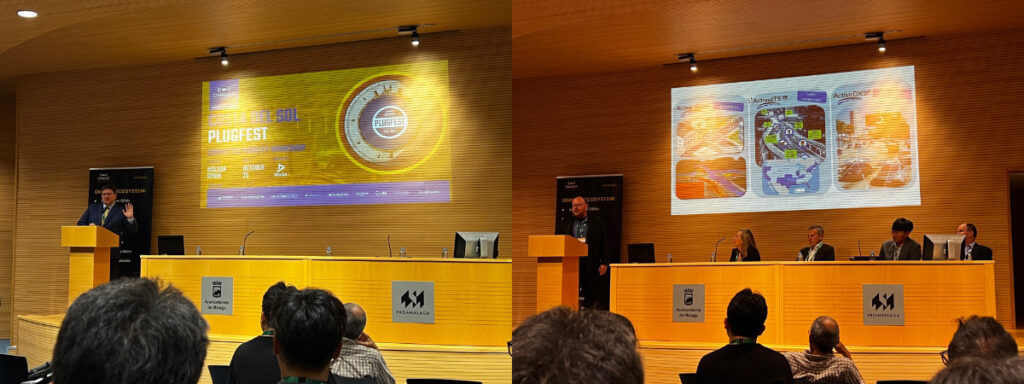There are two major approaches to achieving autonomous driving. The first is ADAS (advanced driver-assistance systems). And the other is V2X (vehicle-to-everything). Although the public is now quite familiar with ADAS, V2X remains a relatively unknown field. Even among industry stakeholders, a common misconception about V2X is that it must be deployed on a mass scale to provide meaningful benefits. In this blog, we explain why V2X deployment might not be as big an investment as it might seem, by looking at some of the short-term benefits of V2X.
Why It Doesn’t Need to Be Mass Deployment
Indeed, the ultimate objective of V2X is to create a fully connected mobility ecosystem that enables a state of full driving automation (Level 5), where vehicles seamlessly communicate with their surrounding vehicles and infrastructure through exchanging messages in real-time, overcoming the shortcomings (e.g., blind spots, failed object recognition) of cameras and sensors. This approach towards autonomous driving is also referred to as Vehicle-Infrastructure Cooperated Autonomous Driving (VICAD).
However, establishing an entire V2X ecosystem is a long process, as it can take many years to transform an entire city’s transport infrastructure into V2X-enabled systems. Therefore, industry players shouldn’t solely focus on the final objective of VICAD, but instead, work towards deploying V2X for its immediate benefits. This way, consumers can start benefiting from V2X sooner, which helps generate momentum to accelerate further investment and deployment.
Imaging planning and building a subway network from scratch. Of course, the final goal is to create an interconnected network that covers the entire city. However, if the public must wait until an entire network to be completed before benefiting from it, there would be very little interest in moving the project forward. Instead, cities start by building and operating a single line to allow at least some consumers to benefit from it in the short term.
The same is true for V2X. It doesn’t need to be mass deployment before we can start to see benefits. Some case-specific applications, including Signal Phase and Timing (SPaT) and emergency vehicle preemption (EVP), have already generated some promising short-term benefits in terms of road safety and efficiency.
The Short-Term Benefits of V2X
1. Road safety
Even with selective, small-scale deployments over the short term, V2X opens the opportunity for many creative approaches to enhance road safety. For instance, V2X roadside units (RSU) can be installed onto traffic signals at selected intersections where car accidents frequently occur, enabling Signal Phase and Timing (SPaT). SPaT is a V2X application where the traffic signal informs incoming vehicles of the remaining time of the signal. When vehicles receive that information, they can automatically determine whether to continue to cruise through the intersection, slightly accelerate to pass through prior to the signal change, or gently decelerate to a full stop. Having machines do the timing and calculation can help reduce human misjudgments at intersections.
It might be tempting to think that SPaT is only beneficial when all vehicles are equipped with V2X onboard units (OBU). Of course, the more V2X-enabled vehicles there are, the more effective the use case becomes. Still, if only a quarter of vehicles were to be equipped with V2X OBUs, SPaT would make a significant difference by improving the safety record of the intersection. This is because drivers have a natural tendency to move with the flow. The behaviour of V2X-enabled vehicles will influence the behaviours of surrounding drivers, encouraging them to comply with the coordination as well, hence reducing the likelihood of dangerous acceleration and braking during yellow lights.
Installing RSUs at intersections enables another common use case known as emergency vehicle preemption (EVP), which is currently deployed in many major cities across the globe. This is where OBUs installed in ambulances and fire trucks communicate with RSUs at intersections, prompting the traffic signal to change in favour of their direction, making it a very useful application in dense city streets where emergency vehicles can easily get stuck in gridlocks.
As such, localized V2X applications like SPaT and EVP do not require mass deployment. Hence, infrastructure operators and automotive OEMs can focus primarily on these short-term benefits.
2. Traffic efficiency
Besides safety, traffic efficiency is one of the other short-term benefits of V2X. A promising V2X-enabled solution that helps increase traffic efficiency is truck platooning. This is when a fleet of trucks cruise in a row at the same speed in the formation of a train. Given that trucks take up a significant percentage of the highway, having trucks travel individually at different speeds across different lanes can slow the overall traffic and lead to potential safety hazards. By lining them up in a lane at a consistent speed, a significant amount of space can be freed up, enabling faster travel speeds, and reducing the level of congestion during peak times. Furthermore, truck drivers in the follower trucks will be able to rest during the trip, reducing the likelihood of driver fatigue, hence enhancing road safety as well.
Another localized application of V2X is smart parking. This is when RSUs equipped in parking lots communicate with OBUs in nearby vehicles to inform them about parking space availability. In busy urban centers, a great amount of aggregated time is spent on searching for parking space. Not only is it a frustrating experience to circle around a busy block looking for the nearest available parking space that doesn’t cost a fortune, but those in search of parking can add up to the existing traffic and cause further congestion. With V2X-enabled smart parking, there will be no need to roam around urban streets for parking.
3. Cost saving
Road transportation comes with a cost. Apart from fuel and maintenance costs, every minute spent sitting in traffic is an opportunity cost that can be measured in the form of lost productivity. According to the 2021 INRIX Global Traffic Scoreboard, traffic congestion in the United States costs the average driver $564 in lost productivity throughout the year, and an aggregated $53 billion to the country.
When RSUs are deployed in critical areas such as frequently congested intersections and highway merges, V2X-enabled traffic coordination like SPaT and lane merge assists can reduce congestion remarkably, thus cutting unnecessary fuel consumption and productivity loss.
4. Environmental sustainability
When it comes to sustainable transport, electric vehicles (EV) are the most effective solution that contributes directly to a reduction in carbon emissions. However, many do not realize that V2X is another promising technology that can make a positive impact on environmental sustainability.
This is because V2X is an effective energy saver. As aforementioned, since V2X applications can help coordinate traffic and reduce congestion, the average vehicle spends less time on the road, with less unnecessary acceleration and braking. This results in not just less emission, but also less electricity consumption for EVs. Although this might seem like a subtle difference for a single vehicle, the accumulated energy savings and emission cuts can make a meaningful impact on the environment.
Additionally, just like emergency vehicle preemption, OBUs can also be installed on buses and street cars so that traffic signals can give priority to public transit, making traveling by public transit more efficient and convenient, thus encouraging greater usage.
5. Convenience
Regardless of its application, a common benefit that V2X brings across all use cases is convenience. Through real-time communications, road users will be able to benefit from a smart and connected mobility environment.
Start Small, Think Big
Back to the point — V2X connectivity isn’t all about the big picture of full autonomous driving. Through vehicle-infrastructure cooperation, V2X can be utilized for a wide range of localized use cases that do not require much time and effort to deploy. Eventually, these local deployments will naturally accumulate to shape an interconnected V2X ecosystem, enabling a complete VICAD experience. Therefore, policymakers, infrastructure operators, OEMs, and investors should push forward V2X deployment by focusing primarily on its immediate benefits.
Securing V2X Communications
An integral component of V2X deployment is cybersecurity. Encryption and PKI-based authentication measures must be preestablished within the communication end-entities (OBU/RSUs) to ensure that the messages communicated via V2X are securely protected from unauthorized access and tampering. Conversely, with more and more localized V2X deployments, cybersecurity capability will continuously improve with enhanced regional security policies.
AUTOCRYPT’s secure V2X communications solution strengthens both privacy and safety for V2X applications, including a security module installable onto OBU/RSUs, a Security Credential Management System (SCMS) that issues, revokes, and manages digital certificates for end-entities, as well as an Integrated Management System (IMS) for SCMS that allows automotive OEMs to easily manage all their V2X certificates across all vehicle fleets via a graphical user interface.
To learn more about AUTOCRYPT’s V2X security solutions and offerings, contact global@autocrypt.io.
To stay informed and updated on the latest news about AUTOCRYPT and mobility tech, subscribe to AUTOCRYPT’s quarterly newsletter.




